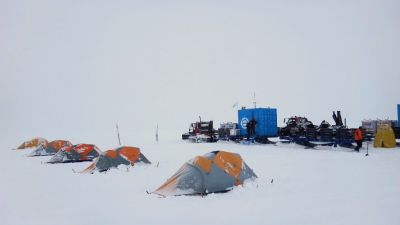
Sea ice creates challenges for the Princess Elisabeth team
While on their field expedition to help Denis Lombardi from the Royal Observatory of Belgium install several seismometers, Alain and six others took advantage of the trip away from the station to do some reconnaissance work to find an ideal place for the supply ship to unload its heavy cargo, which will include the last fresh food shipment of the season, heavy machinery, and parts to repair three wind turbines at the station.
When sea ice gives you problems, follow the penguins!
The team surveyed two previous places where ships supplying the station unloaded their cargo in previous years: Crown Bay and Breid Bay. However due to extremely difficult ice conditions, it appears that neither of these previous places on the coast will be useable this year due to much thicker sea ice than usual.
Alain said that in all the years that he’s been to this part of the coast in East Antarctica, he’s “never seen sea ice so thick.” He tried to schedule the arrival of the boat as late in the season as possible to allow more time for the annual summer sea ice melt that takes place every austral summer to get rid of more sea ice.
The captain of the supply ship is considering anchoring in an area not far from the penguin colony that Alain and station team members have encountered over the last two seasons while helping scientists conduct research at the coast. As penguins feed on fish and thus need to dive into the water often as they search for food, their colonies tend to be in areas where open water abounds, which means sea ice will be less plentiful in areas where penguins congregate.
However this new location is about 150 km away from Crown Bay along the coast, which means it will require additional fuel and additional reconnaissance to map out a safe trail for the vehicles that will transport the containers back to the station once unloaded. And as the Princess Elisabeth team had already dropped off containers at Crown Bay to load onto the boat at Crown Bay for shipment back home, these containers will need to be transported to the new as-yet-to-be-finalised lodaing/unloading location on the coast.
The quest for the perfect ice shelf
Finding a way through the sea ice is only the first logistical challenge to overcome. Finding the right place for the ship to anchor is key to ensuring smooth unloading and loading operations. A nice, stable ice shelf is an ideal place to unload cargo, as ice shelves tend to be thick and support the weight of supply containers and equipment.
However the ice shelf need to fit within certain parameters to be suitable as an unloading point. The ice shelf cannot be more than 20 metres high, as the supply ship’s crane won’t be able to hoist anything above this height (many ice shelves rise 30 to 40 metres above the water in this part of East Antarctica). The part of the ice shelf that lies underwater - which comprises the majority of an ice shelf’s mass - cannot protrude excessively, either. The edge of the ice shelf needs to have an abrupt cliff-like edge, yet the ice shelf cannot be flowing fast enough so that icebergs calve off the end of it too frequently (an ice shelf flows on average between half a metre and a metre per day as it transports the ice flowing off of the Antarctic Ice Sheet out over the Southern Ocean).
Alain and the captain of the supply ship must be in constant communication. Only by communicating with one another can they find the best place along the coast to conduct unloading and loading operations. The station shares sea ice data it gets from satellite images it receives, and Alain’s long experience working along the coast of East Antarctica is essential when choosing the right location to conduct operations.
Ready to spring into action on a moment’s notice
As soon as the captain tells the station that the supply ship has found a good unloading point, Alain and a 10-member team will start the drive to the coast in tractors to pick up the containers. They’ll have to drive 30 hours non-stop, which means team members will have to drive in shifts, with one driving while the others sleep. As conditions at the coast can change rapidly, time is of the essence.
During the the unloading and loading process, the team will make use of individual mobile units as a place to camp while they are on the coast. The units transport fuel and other equipment they need, including tents, a snow-melter, and a mobile toilet. Once the team chooses a spot to camp, it only takes half an hour to set everything up. Nicknamed Emile and Ernest, the two mobile containers allow the team to be completely self-sufficient while in the field. And as the team has a greater distance to cover this year, being able to carry extra fuel will allow them to be more mobile in the field.
Lots of challenges lie ahead for the Princess Elisabeth team. Stay tuned to see how they manage ot tackle them!
Picture: The Princess Elisabeth team camping in the field close to the coast. - © International Polar Foundation
